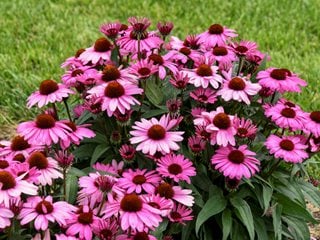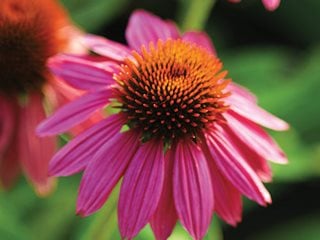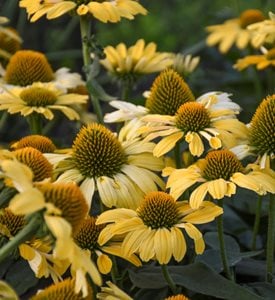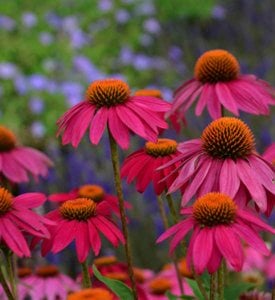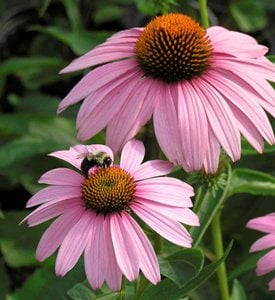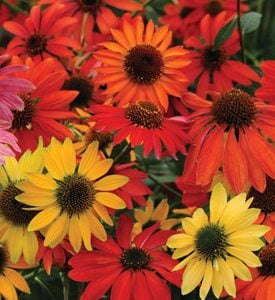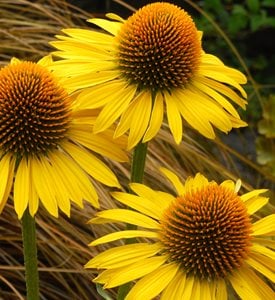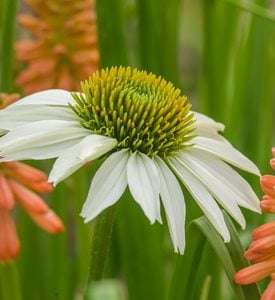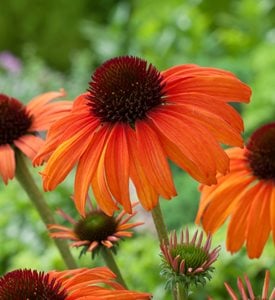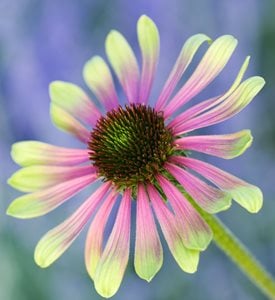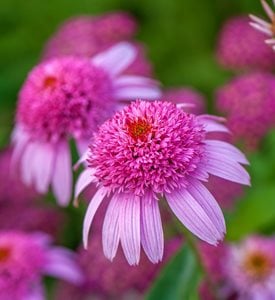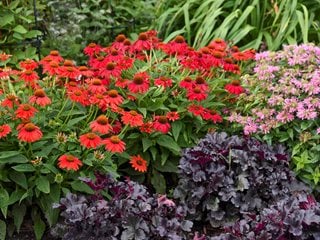Growing Coneflower: How to Grow & Care for Echinacea
Learn about purple coneflower and other vibrant Echinacea plantsConeflowers are popular perennials with good reason. They are heat and drought resistant, easy to grow, bloom for months, make great cut flowers, and attract birds and pollinators.
Coneflowers come in glorious shades of pink, orange, yellow, red, and chartreuse, as well as a range of flower forms—standard shuttlecock to horizontal ruffs to doubles with a powder-puff center. What more could you ask?
On this page: Basics | Growing Tips | Care | Pictures | FAQs | Design Ideas
On this page:
- Coneflower Basics
- How to Plant Coneflower
- Coneflower Care
- Coneflower Pictures
- Frequently Asked Questions
- Design Tips
BASICS
Zones: 3-9, varies by species
Height/Spread: Varieties 2 to 5 feet tall and 1-1/2 to 2 feet wide.
Exposure: Most coneflowers thrive in full sun; some tolerate light shade, especially in hot southern climates. (See more full-sun perennials.)
Bloom time: Varies by species and cultivar, but bloom times usually range from June to August or later.
Flower color: Purple, pink, red, orange, white, yellow, and green varieties are available.
Types: While the purple coneflower, Echinacea purpurea, is most familiar to gardeners, there are other varieties including E. paradoxa, E. pallida, and E. tennesseensis. All are native to the U.S., found in areas across the Midwest and South. Echinacea purpurea, E. angustifolia, and E. pallida are commonly used in herbal remedies.
PLANTING CONEFLOWER
When to plant: Coneflowers are best planted in spring or early fall when temperatures are mild, giving the roots time to establish before extreme weather.
Where to plant: Echinacea should be planted in an area that receives 6 to 8 hours of sunlight a day, as too much shade can result in floppy stems and foliage susceptible to powdery mildew. However, some afternoon shade can prevent burning in southern climates.
How to plant: To plant Echinacea seeds, loosen the soil to a depth of 12 inches. Add compost to the top 2-4 inches of soil. Seeds take approximately 3 to 4 weeks to germinate, and you should see true leaves at about 12 weeks. If transplanting, dig a hole twice as wide as the pot and deep enough so that the rootball will be level with the top of the soil.
CONEFLOWER CARE
These easy-care perennials require only the basics: regular watering of about an inch per week, a light layer of compost added in the spring, and to be cut back in fall, and even that’s optional if you prefer to leave the seed heads.
Deadheading and pruning: Deadheading isn’t necessary, as many coneflowers bloom continuously without it. Leaving spent flowers not only adds winter interest but also provides seed for birds like goldfinches. Plants can be cut back to the ground in fall or spring, but consider leaving 12–24 inches of stem standing. According to North Carolina State Extension, native bees often nest in the hollow stems, so allowing them to remain can support overwintering pollinators.
Soil: Average, well-drained soil.
Amendments & fertilizer: Work a bit of compost in around the plants if flowers are small or poorly developed. Be careful, over-feeding can lead to an abundance of foliage and a lack of flowers.
Watering: Water regularly, but let soil dry out a bit in between. Coneflowers are drought tolerant, but do best in average, dry-to-medium moisture. Coneflowers need at least an inch of water weekly.
Dividing: Divide clumps when crowded, about every 4 years.
Re-seeding: If spent flowers are left intact, they will reseed with little effort on your part. Deadheading can help to control this if they are getting out of hand. Some gardeners choose a middle ground and collect the seeds to plant in carefully selected spots the following season. (Watch a short video from Spoken Garden on how to collect coneflower seeds.)
Diseases and pests: One problem worth noting is aster yellows, a disease caused by a phytoplasma, spread by sap-sucking insects like leafhoppers (can also be spread on pruners when deadheading). It causes deformed blooms, yellowing leaves with green veins, and odd tufts in coneflower cones. According to the Missouri Botanical Garden, there is no cure, so early diagnosis and removal of infected plants is key to preventing its spread.
Coneflowers can also be bothered by leaf miners, powdery mildew, bacterial spots, gray mold, vine weevils, and Japanese beetles.
CONEFLOWER VARIETIES
FREQUENTLY ASKED QUESTIONS
Are coneflowers deer resistant? Many gardeners report that they are deer resistant. Their spiny centers and strong aroma deter deer. However, if deer are hungry enough, they will eat almost anything. Other animals that may take a taste include rabbits, squirrels and woodchucks.
Do coneflowers attract bees and butterflies? Yes! Coneflowers attract butterflies, bees, hummingbirds, and even songbirds. Their long-blooming flowers offer abundant nectar for pollinators, while the seed heads provide food for birds well into fall. See more Bee-Friendly Flowers & Plants for Hummingbirds.
Do coneflowers come back every year? Yes, coneflowers are herbaceous perennials in most zones (USDA Zones 3–9), returning each year from their roots even if the top growth dies back in winter.
Why are my coneflowers flopping over? Flopping may be due to too much shade, overly rich soil, or overcrowding. Taller varieties may benefit from staking in windy areas.
Can I divide coneflowers? Yes, every few years in early spring or fall. Division can help control size and rejuvenate older plants. See more on how to divide perennials.
When should I cut back coneflowers? Cut back in fall after bloom or wait until spring to support wildlife with the seed heads.
Can I grow coneflowers in a container? Yes, dwarf and compact varieties grow well in containers. Make sure the pot has good drainage and enough room for root development.
LANDSCAPING IDEAS WITH CONEFLOWER
- Mix early- and late-blooming varieties to enjoy colorful flowers up to 5 months. Early-bloomers like ‘Green Jewel’ and ‘Merlot’ start flowering in May, while cultivars such as ‘Fatal Attraction’, ‘Pica Bella’, and ‘Springbrook’s Crimson Star’ continue into September.
- Russian sage, black-eyed Susan, Shasta daisy, phlox and liatris make complimentary garden companions.
- Excellent choice for cut flowers with their long, strong stems.
- Add color and height to a mixed container planting.
- Plant in masses in borders, meadows, native plant and wildflower gardens.
Love perennials? Learn more, along with timely planting advice, garden design inspiration, tips and more in our weekly newsletter.
RELATED:
21 Low-Maintenance Plants
20 Flowers for Your Summer Garden
Top Perennial Plants for a Butterfly Garden
24 Purple Flowers to Brighten Your Garden
